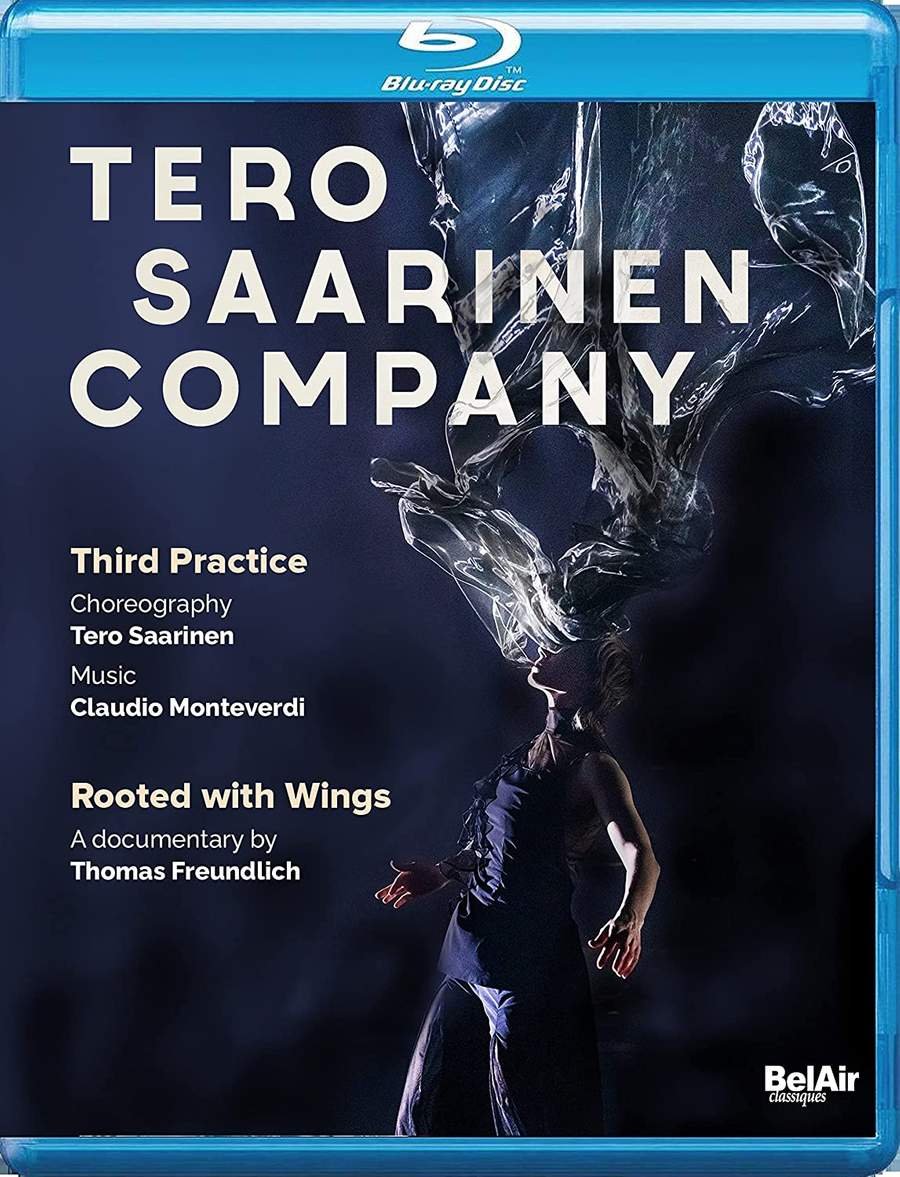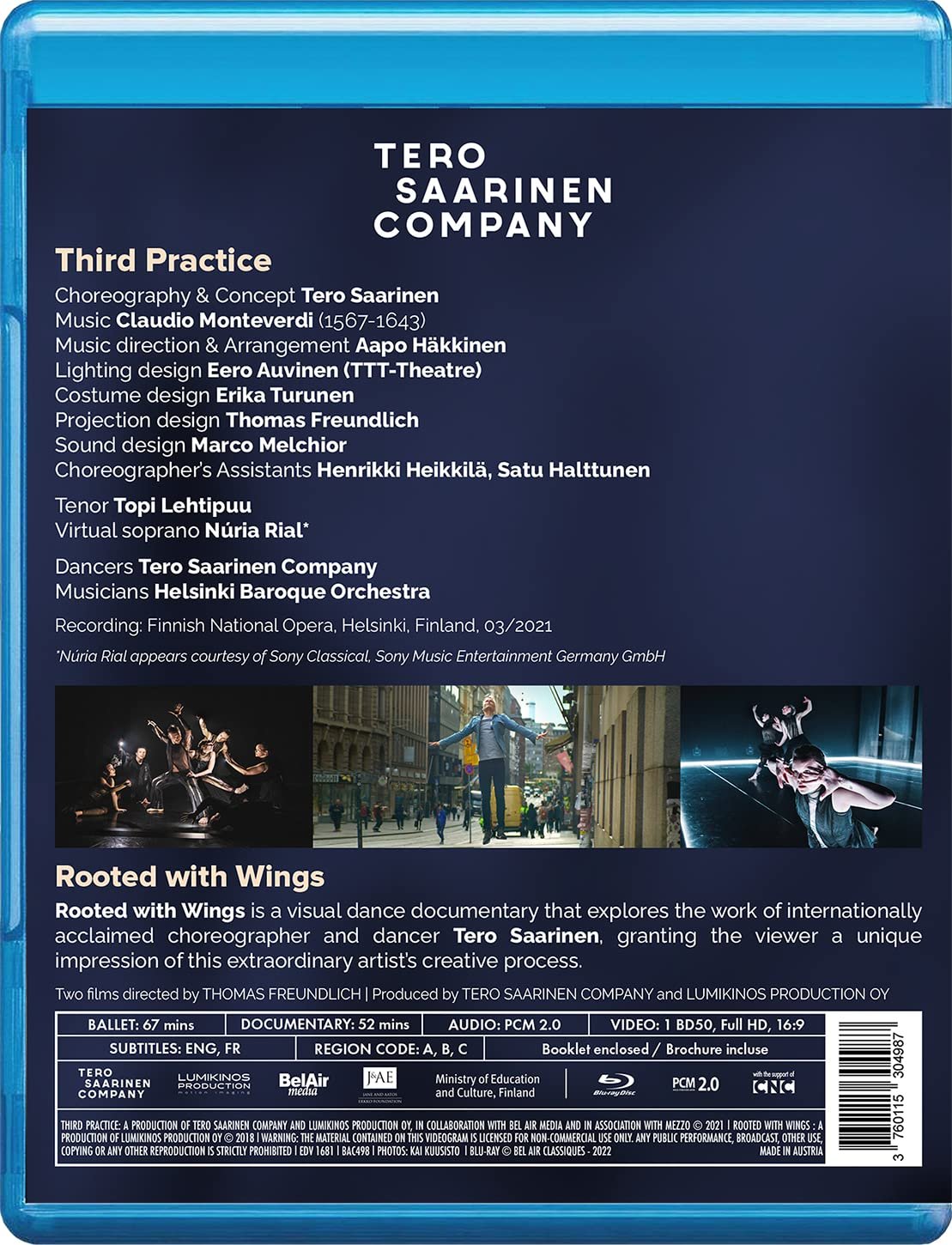

Third Practice modern dance performance. Choreography by Tero Saarinen. Performed 2021 by the Tero Saarinen Company at the Finnish National Opera. Music by Claudio Monteverdi. Aapo Häkkinen conducts the Helsinki Baroque Orchestra with tenor Topi Lehtipuu and “virtual soprano” Núria Rial. Dancers are Jenna Broas, Annika Hyvärinen, Natasha Lommi, Pekka Louhio, David Scarantino, and Eero Vesterinen with understudies Elina Häyrynen, Oskari Kymäläinen, Mikko Lampinen, and Emma Pennanen. Music arranged by Aapo Häkkinen; lighting by Eero Auvinen (TTT-Theatre); costumes by Erika Turunen; projection design by Thomas Freundlich; sound design by Marco Melchior; choreographer’s assistants were Henrikki Heikkilä and Satu Halttunen. Title includes a documentary about the work of Tero Saarinen called Rooted with Wings. Recital and documentary directed for TV by Thomas Freundlich. No subtitles for Third Practice songs in Italian and Latin. Released 2022, disc has PCM 2.0 sound. Grade: B-
You can count the number of world-class, fully-qualified ballet companies on your fingers. But below that level, the world is teeming with innumerable dance outfits that most people never heard of. Some of these companies do good creative work, and the Tero Saarinen Company is one of them. Here’s a crazy picture of Tero:
Tero is actually a highly organized artist with an important dance program in Finland. See his beautiful website (toggles to English). His dance style is modern with Butoh influence. Butoh is a Japanese-origin theater art form. If you should happen to see a man, shaved bald, dressed only in a male cover slowly tumbling down a long stone stairway onto your sidewalk while making no sound at all—don’t call an ambulance. You are only witnessing a Butoh master performing.
I don’t think Tero’s students are asked to fall down steps, but their dancing is “characterized by extreme drama in structured movement and improvisation.” In our first screenshot below, you see 6 dancers in structured positions surrounding a tall man in the center. The beanpole is Topi Lehtipuu, a Finnish A-list opera tenor whom we know from some of our favorite opera Blu-rays. I’m pretty sure Tero and Topi have been friends since grade-school days. Note below that the musicians are on the rear of the stage obscured by semi-transparent fabrics hanging from the ceiling. Here Topi is singing something called Riternello in Chapter 2 of the disc. The word “ritornello” means “refrain” or “chorus.” But nothing connected with the title reveals which refrain Topi is singing:
Dancers are athletes who have to retire at about age 40. Topi was 50 years old when he risked his life dancing wildly with artists half his age. I should also mention now that Tero and his team have added many sound effects, elements of electronic music, and post production echos or repeats of parts of the sung music. There is a lot stuffed into this title:
In the next shot below, virtual soprano Núria Rial appears in Chapter 3 as a projection on one of fabrics on the rear of the stage hanging from the ceiling. Núria is singing the madrigal Con che soavità. This is not very attractive or impressive. Later we will see better virtual images of Núria:
Tero is known for injecting creative staging, costumes, props, and lighting into his work. In Third Practice, light-weight fabrics (like those on the back of the stage) are also used as props that float (on puffs of air) around the dancers. We see this below in Chapter 4 when Topi sings the madrigal O quam pulchra es to his beloved. The next shot below is a great image of the blowing fabric and the beautiful dancer on stage with Topi:
Núria shares the madrigals with Topi. She has recorded a lot of classical music. She’s almost as old as Topi, and it seems she was not interested in risking her neck on stage. Ergo, she appears virtually. In the next shot below, we see a tiny Núria projected on the back of a dancer while we hear Núria singing the madrigal Quel sguardo sdegnosetto in Chapter 5:
And next below, still in Chapter 5, we see 5 different versions of Núria in a kind of chorus:
The dancing gets more intense. Now in Chapter 6, Topi, singing the madrigal Mentre vaga Argioletta, finds himself on the bottom of a kind of rugby scrum. The main lights are down and dramatic scenes are created with hand-held LEDs:
Suddenly lights running around the stage come up to create a different atmosphere. Maybe some stage smoke was quietly added to the mix. We are still in Chapter 6:
In Chapter 7 we get more magic with floating fabrics:
As well as the most impressive virtual images of all: the duet madrigal Tirsi e Clori sung by real Topi and virtual Núria. Plus, if that isn’t enough, we get multiple Núrias:
And multiple Topis:
And flags:
This extended orgy of special effects cools down as we move into Chapter 8. The 5 Monteverdi madrigals sung by Topi and Núria were all romantic. So we slip now into a dance duet seen below to orchestral music only. I’m afraid to try to ID these two. The headshots of the dancers on the Company website are beautiful. But so many of the dancers look alike!
All the clever music, singing, and dancing shown above is supported equally clever lighting and costumes. Tero has packed about as many elements, twists, turns, and angles into this show as one could imagine..
My screenshots and the trailer should tell you if you are interested in seeing this Butoh-inspired dancing. I had no trouble with the style except that after the half-way mark, I started to tire a bit from seeing so much of the same attitudes. And I wonder if there is a disconnect between the romantic madrigals and the challenging and sometimes even brutal dance moves.
My favorite features were (1) the combination of the singers and the dancers (2) the interesting lighting, and (3) the scarfs floating in the air. I did not much care for the projections of the virtual soprano. Maybe virtual Rial looked better on stage than in the video. The lighting was low, and that may be why the PQ was was not pin sharp. Maybe TV director Freundlich aimed at an “atmospheric” look in his video.
Freundlich is a newcomer to Blu-ray fine-art video. So I ran the numbers on his video content. Not exciting. His average clip is only 7.7 seconds, which is midway between a typical fine-art DVD and the pace we would expect for a proper ballet or dance show in hi-def TV. And only 67% of his video clips show the whole bodies of the dancers. So we have a clear diagnosis of DVDitis. Lets hope Freundlich reads our discussions of DVDitis before he shoots his next fine-art video.
The SQ seemed fine. I enjoyed the orchestra music. I could track Topi’s singing fairly well with help from copies of the lyrics I found on the Internet. I was not able to understand a lot the soprano music. Could this be weak diction in Italian? Well, Núria Rial is Spanish, and any Spanish opera singer would have to know Italian perfectly. So I suspect the lyrics the singers learned were not exactly the same as the lyrics I came up with. Or maybe the musicians rearranged some of the lyrics for their own reasons. And I never got a clue as to what Topi was singing about in the Ritornello of Chapter 2.
So some help with the lyrics would have been welcome. But, alas, the BelAir disc authorship for this title is atrociously bad. First, there are no subtitles in Third Practice for the singing in Italian and Latin. Cheap! And there are no lyrics in any language in the keepcase booklet. Cheaper! Nor does the booklet identify the origin of the opening refrain. The booklet is ugly and hard to read. Instead of giving useful information, the booklet insults the reader with two pages of ridiculously hagiographic baby food about Tero.
I try to fight back against this abuse from BelAir by attaching below lyrics for the music in Italian and English. If you are an expert on Monteverdi, maybe you can come up with versions of the lyrics that exactly match the singing on the disc.
Finally, there is a documentary about Tero. Most bonus docs are atrocious. But this one is well done, is mildly interesting, and has subtitles. G’rrrrr.
Now to a grade. For BelAir, I would give this a D for so many unforced errors of neglect and omission. And with the DVDitis, and this title deserves an F for BelAir. But that would be too harsh on brother Tero. There is a lot about this dance show to admire. The title holds up on repeat viewings as you always see something new. I think Tero and his crew really poured their hearts into this production. So that gets me to a C+, which still seems cruel. B- is the best I can do.
Here’s an official trailer—it’s similar to the disc but from a different recording with different costumes:
OR
PS: Here are lyrics for the madrigals by Claudio Monteverdi—just click on the red text for the link:















